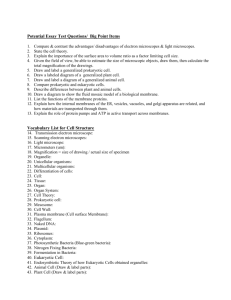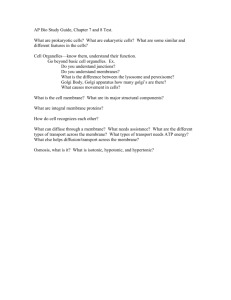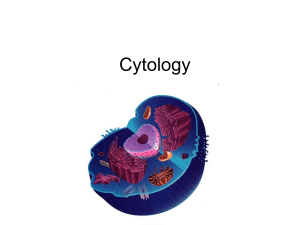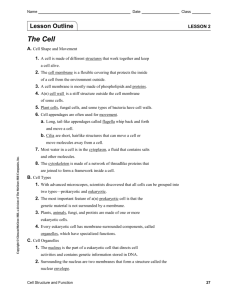Introduction: Biology Today Chapter 1
advertisement
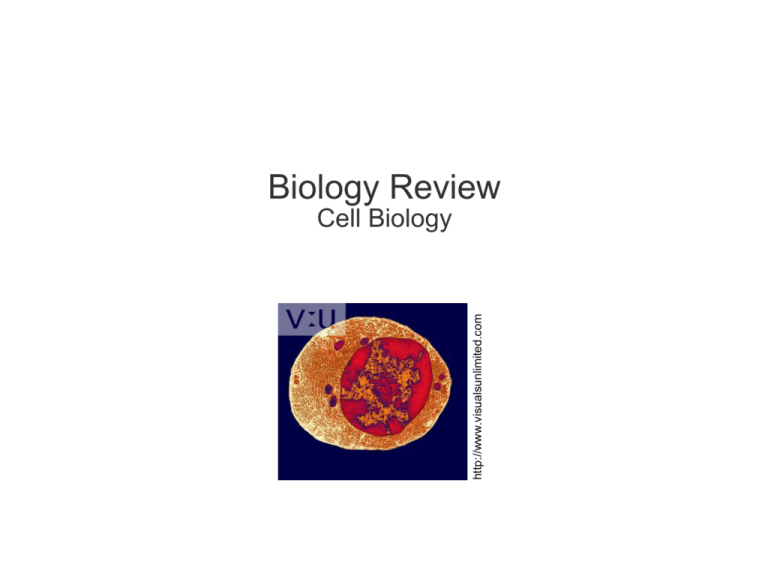
http://www.visualsunlimited.com Biology Review Cell Biology Note Much of the text material is from, “Essential Biology with Physiology” by Neil A. Campbell, Jane B. Reece, and Eric J. Simon (2004 and 2008). I don’t claim authorship. Other sources are noted when they are used. 2 Outline • Cell theory • Microscopy • Cells and their components 3 Cell Theory 4 Cell Theory • Cells were first described in 1665 by the British scientist, Robert Hooke, from microscopic examination of thin slices of cork from Mediterranean oak trees. • Over the next two centuries, cells have been found in all organisms that were examined. • The accumulation of evidence led to cell theory: all organisms are composed of cells. • Cell theory was later expanded to encompass observations that cells arise from previously existing cells—that is, cells do not spontaneously form. 5 Cellular Structure of Cork http://www.isa.utl.pt http://farm1.static.flickr.com Robert Hooke’s drawing. http://cache.eb.com 6 Microscopy 7 Microscopic World of Cells • Every cell in a living organism is intricate and extremely complex. • The most elaborate machine, if it were reduced to the size of a cell, would seem simple in comparison. • Cells must be very small for materials to to move in and out to meet their metabolic needs. 8 Microscopic World of Cells (continued) • Organisms are single-cellular (bacteria, archaea, and some protista) or multi-cellular (other protista, fungi, plants, and animals). • The human body has many trillions of cells that work cooperatively to perform their functions, which is a focus of this course on human physiology. 9 Light Microscope • The light microscope was invented during the Renaissance, about 400 years ago. • Visible light passes through a specimen—the lens enlarges the image and projects it onto the retina of the human eye, film camera, or electronic sensing device. • Modern light microscopes have compound lenses to reduce chromatic (color) aberration and spherical aberration to improve the quality of the viewed image. 10 http://www.meijitechno.com Light Microscope (continued) A modern lab and classroom version. 11 Magnification and Resolving Power • Two key aspects of microscopes are their magnification and resolving power. • Magnification is the increase in an object’s apparent size compared to its actual size. • Resolving power is the ability to show two or more objects as distinct entities. • Due to limitations in resolving power (about 0.2 m), the maximum useful magnification of a light microscope ranges between X400 and X1000. 12 http://www.uwash.edu Light Micrograph Red blood cells and a stained white blood cell. 13 Another Light Micrograph http://www.emsdiasum.com Coronal cross section of a rat brain under low-power magnification (about X10). 14 Do you have experience using a light microscope? If so, what did you discover? 15 Electron Microscope • Electron microscopes use electron beams rather than light to access a very small world. • Resolving power is much higher than for light microscopes, allowing for much higher useful magnifications. • Electron micrographs can be produced at magnifications of X100,000 or higher. • The study of cells advanced rapidly when electron microscopes were developed in the 1950s. 16 http://www.usaft.af.mil Electron Microscope (continued) A somewhat dated, electron microscopy laboratory. 17 Types of Electron Microscopes • Scanning electron microscopes are used to study the surfaces of cells. • Transmission electron microscopes are used to explore the internal structures of cells. • Electron microscopes are used with prepared (dead) specimens, while light microscopes are suited for either live or prepared specimens. 18 http://www.allergy-details.com Electron Micrograph A collection of pollens. 19 http:www3.niaid.nih.gov Another Electron Micrograph Escherichia coli (E. coli). 20 Cells and Their Components http://www.steve.gb.com 21 http://www.visualsunlimited.com http://www.visualsunlimited.com Prokaryotic and Eukaryotic Cells Prokaryotic cell Bacteria and archaea (bacterium shown) Not to scale: A prokaryotic cell is about 1000 times smaller in volume than a eukaryotic cell. Eukaryotic cell Plants, animals, and fungi (animal cell shown) 22 Cell Comparisons • Prokaryotic cells first appeared about 3.5 billion years ago; eukaryotic cells appeared about 1.8 billion years later. • Eukaryotic cells are much larger—they are about ten times the diameter of prokaryotic cells and their volume is even greater (by about a thousand times). • The DNA in eukaryotic cells is in the nucleus surrounded by a membrane, while the DNA in prokaryotic cells is in an unenclosed central region. • Prokaryotic and eukaryotic use different processes for copying their DNA (replication versus transcription). 23 How do some types of prokaryotic cells affect our lives? 24 Cell Comparisons (continued) • Eukaryotic cells have several types of membrane-enclosed organelles with specialized functions, while prokaryotic cells have far fewer. • Eukaryotic cells use aerobic respiration and anaerobic respiration for chemical energy production, while prokaryotic cells only use anaerobic respiration. Organelle = a compartment within a cell that has a specialized function, for example, ribosome, lysosome, Golgi apparatus, or mitochondrion. (http://sis.nlm.nih.gov/enviro/iupacglossary/glossaryo.html) Most of these membrane-enclosed organelles, as we will discuss, are unique to eukaryotic cells. 25 Some Animal Cell Types 3. Adipose 1. Blood 4. Intestinal 2. Purkinje (cerebellum) Images 1 and 2, http://upload.wikimedia.org Image 3, http://www.proteinpower.com Image 4, http://focus.harvard.edu 26 Components of Eukaryotic Cells Component Plasma membrane Nucleus Chromosomes Cytoplasm Ribosomes Endoplasmic reticulum Golgi apparatus Lysosomes Mitochondria Cytoskeleton Vacuoles and vesicles Flagella and cilia Centrioles Cell wall Chloroplasts Central vacuole Animal cell Plant cell x x x x x x x x x x x x x x x x x• x x x ---- Rare x x x Rare x x x x 27 Plasma Membrane • A plasma membrane separates the intracellular space of a cell from its surrounding extracellular space. • The plasma membrane defines the cell boundary. • The membrane is a double layer (bilayer) of phospholipid molecules. Computer generated graphic http://www.sci-design.com 28 Plasma Membrane (continued) • The glycerol heads with their attached phosphate groups orient toward the fluids in the intracellular and extracellular spaces because they are hydrophilic. • The two lipid tails attached to the glycerol molecule orient inward since they are hydrophobic. • Phospholipid membranes are self-organizing because of their hydrophilic and hydrophobic properties. 29 Plasma Membrane (continued) • Chemical receptors and other protein molecules are embedded in the plasma membrane. • The plasma membrane is not a static structure of molecules fixed in place. • Phospholipids and most proteins are drift about in the plane of the membrane, much like icebergs floating in the high-latitude oceans. • Therefore, the plasma membrane is described as a fluid mosaic. 30 Selective Permeability, Membrane Transport • The plasma membrane and membranes that enclose organelles are selectively permeable. • The membranes allow some substances to pass while blocking others from entering a cell. • Some substances can diffuse across the plasma membrane including O2, CO2, and some nutrients. • The passage of other substances requires the use of transport proteins through the plasma membrane. • Glucose, a major source for cellular energy, is attached to a transport protein to enter cells. 31 Nucleus • The nucleus of a cell has the genetic code of life in the form of DNA. • The nucleus is enclosed in a double membrane known as the nuclear envelope—it is similar in molecular structure to the cell’s plasma membrane. • Pores in the nuclear envelope permit the passage of material between the nucleus and cytoplasm (messenger RNA and components of ribosomes). Electron micrograph http:.//www.science.org.au 32 Nucleus (continued) • DNA molecules and proteins in the nucleus form long fibers called chromatin. • Each fiber makes-up one chromosome—humans usually have 46 chromosomes in somatic cells of their bodies. • A ball-like mass in the nucleus, called the nucleolus, produces the components of ribosomes. 33 Cytoplasm • The cytoplasm is the region between the cell’s plasma membrane and its nucleus. • It contains organelles suspended in a fluid known as cytosol. • Each type of organelle performs specific functions, as we will discuss. • Most organelles in eukaryotic cells have their own phospholipid membranes. Electron micrograph http://www.danforthcenter.org 34 Ribosomes • Ribosomes are found in the cytoplasm, and often in close proximity to the cell nucleus. • These organelles synthesize the polypeptides that make up proteins from amino acids. Computer generated graphic http://rna.ucsc.edu 35 Ribosomes (continued) • The genetic information of DNA is transferred via messenger RNA (mRNA) to the ribosomes to provide instructions for the synthesis of polypeptides that form proteins. • Some ribosomes synthesize proteins for use in the cytoplasm or plasma membrane. • Other ribosomes make proteins for secretion by the cell for use by other cells. 36 Endoplasmic Reticulum • The endoplasmic reticulum (ER) synthesizes many types of biological molecules. • ER is made-up of an elaborate system of tubes and sacs in the cytoplasm. • The two types of endoplasmic reticulum are rough ER and smooth ER. Electron micrograph http://www.bu.edu 37 Rough ER • Rough ER has the appearance of roughness due to the ribosomes that stud its surface. • Rough ER produces proteins found in the plasma membranes of cells and organelles, and for secretion by the cell. • Cells that secrete substantial amounts of proteins, such as salivary glands of the mouth, are rich in rough ER. • Products are sent to other locations in the cell in membrane covered packages called transport vesicles—the vesicles bud and separate from the ER. 38 Smooth ER • Smooth ER lacks the ribosomes that stud the surface of rough ER. • One function is the synthesis of steroids in the testes, ovaries, and adrenal glands. 39 Smooth ER (continued) • Smooth ER in liver cells (known as hepatocytes) produce enzymes that detoxify drugs and poisons in the blood. • The amount of smooth ER increases (up-regulates) with exposure to certain drugs. • The body increases its tolerance to the drug, which requires higher dosages to achieve the same physiological effect. • One hallmark of addiction is increased drug tolerance (along with a psychological component). 40 Golgi Apparatus • The Golgi apparatus works with the endoplasmic reticulum to refine, store, and distribute molecules synthesized by the cell. • Products synthesized in the ER reach the Golgi apparatus via transport vesicles. • Enzymes in the Golgi apparatus modify many of the products synthesized by the ER. Electron micrograph http://www.bu.edu 41 Golgi Apparatus (continued) • The Golgi apparatus is named for its discoverer, Camillo Golgi. • They work with the ER to refine, store, and distribute chemical products. • The Golgi apparatus tags proteins with addresses of their destinations within the cell. • Vesicles that bud from the Golgi apparatus distribute products to other organelles. • Other products are sent to the plasma membrane for secretion by the cell. 42 Lysosomes • Lysosomes are membrane-enclosed sacs of enzymes for digestion to prevent self-destruction of the cell. • The enzymes breakdown macromolecules including proteins, glycogen, fats, and nucleic acids. • Molecules from this process nourish the cell. Electron micrograph http://biology.unm.edu 43 Lysosomes (continued) • Other lysosomes function as recycling centers by engulfing and digesting damaged organelles and making some of these molecules available for the synthesis of new organelles. • Lysosomes in white blood cells ingest bacteria—their enzymes destroy bacterial cell walls. • Another type of lysosome destroys the webbing that joins the fingers in human embryos. 44 Mitochondria • Mitochondria perform cellular respiration to harvest chemical energy for cellular work. • The processes, known as the Krebs or citric acid cycle and the electron transport chain, are aerobic since as require a continuing supply of oxygen molecules. • Sugars and other types of food molecules are converted to a form of energy known as ATP. Electron micrograph http://is2.okcupid.com 45 Mitochondria (continued) • The inner membrane of a mitochondrion contains enzymes and other molecules for cellular respiration. • The membrane has many folds to increase its surface area and maximize ATP output. • Mitochondria may have been invaders in the earliest eukaryotic cells. • Now, a symbiotic relationship exists between mitochondria and eukaryotic cells. Mitochondria—plural; mitochondrion—singular. Symbiotic = an interaction between dissimilar organisms, especially when they benefit each other. 46 Mitochondria (continued) • Mitochondrial DNA is passed through maternal lineage from mother to daughter. • The DNA maintains remarkable stability from generation to generation. • These aspects enable mitochondrial DNA to be used in tracing population groups 10,000 years or more back in time as they have migrated. 47 Cytoskeleton • Microtubules of several different proteins form a network of fibers known as the cytoskeleton. • The cytoskeleton is found in the cytoplasm. • It provides structural support for a cell and a means for specialized movements. Color enhanced electron micrograph http://www.bcsb.org 48 Cytoskeleton (continued) • Microtubules also hold the organelles in place in the cytoplasm and guide the movement of vesicles. • Other microtubules guide the movement of individual chromosomes when cells divide. 49 Cytoskeleton (continued) • Unlike a bony skeleton, a cytoskeleton can be rapidly dismantled in one location to reform in a new location of the cell. • This process occurs through the removal and replacement of its protein units. • It contributes to the crawling motion of single-cell amoeba and movement of white blood cells. 50 Vacuoles and Vesicles • Vacuoles and vesicles are membrane enclosed sacs that bud from a cell’s plasma membrane, endoplasmic reticulum, and Golgi apparatus. • They differ in their functions—for example, vacuoles in the plasma membrane of a cell engulf food molecules for transportation to the lysosomes. In neurons, vacuoles known as synaptic vesicles store neurotransmitters to communicate with other neurons, muscles, and glands. Electron micrograph http://www.pharmacology.com 51 Flagella • Some eukaryotic cells have appendages and specialized microtubules that enable movement. • Flagella (singular: flagellum) propel cells by an undulating, whip-like motion. • Flagella usually occur singly—for example, in sperm that must travel the length of the female reproductive tract to fertilize an egg released by an ovary. Human sperm, Electron micrograph http://www2.sunysuffolck.edu 52 Cilia • Cilia, which are usually shorter and more numerous than flagella, produce motion through rhythmic back-and-forth movements (think of the rows of oars on an ancient galley ship). • The cilia of cells in the oviducts (fallopian tubes) can sweep a fertilized egg along the reproductive path for implantation in the uterus. http://www.gibinquirer.net Electron micrograph http://www.talbotcentral.ucr.edu 53 Cilia (continued) • Tobacco smoke can damage or destroy the cilia in the bronchial tubes, which interferes with the body’s normal means for removing pollutants from the lungs. • Smoker’s cough is the body’s compensatory attempt to cleanse the respiratory system. 54 Extracellular Matrix • Most animal cells secrete a thick, sticky substance called extracellular matrix. • It helps hold cells together in tissues, and provides protective and supportive functions. 55 Cell Junctions • The cells in many animal tissues are connected by cell junctions. • Tight junctions bind cells to form a leak-proof sheet of tissue such as in the small intestine and large intestine to prevent fluids from leaking into the abdominal cavity. • Anchoring junctions bind cells together while allowing some molecules to pass among the spaces between them. • Communicating junctions contain channels to permit water and other small molecules to flow among neighboring cells. 56 Centrioles • Centrioles are can-shaped structures of microtubules in the cytoplasm that support cell division. • We will cover their functions when we discuss mitosis and meiosis in the next lecture. Computer generated graphic http://www.sparkleberrysprings.com 57 Can you describe the components of an animal eukaryotic cell and their basic functions? 58
